2022年中考英语考点专项突破复习课件 第四节 形容词和副词(共35张PPT)
文档属性
| 名称 | 2022年中考英语考点专项突破复习课件 第四节 形容词和副词(共35张PPT) |  | |
| 格式 | pptx | ||
| 文件大小 | 31.9MB | ||
| 资源类型 | 教案 | ||
| 版本资源 | 牛津译林版 | ||
| 科目 | 英语 | ||
| 更新时间 | 2022-05-13 16:05:51 | ||
图片预览

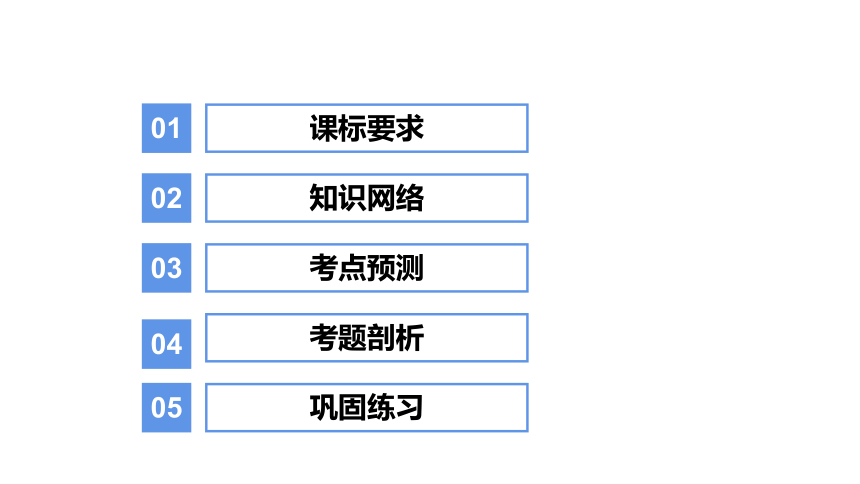




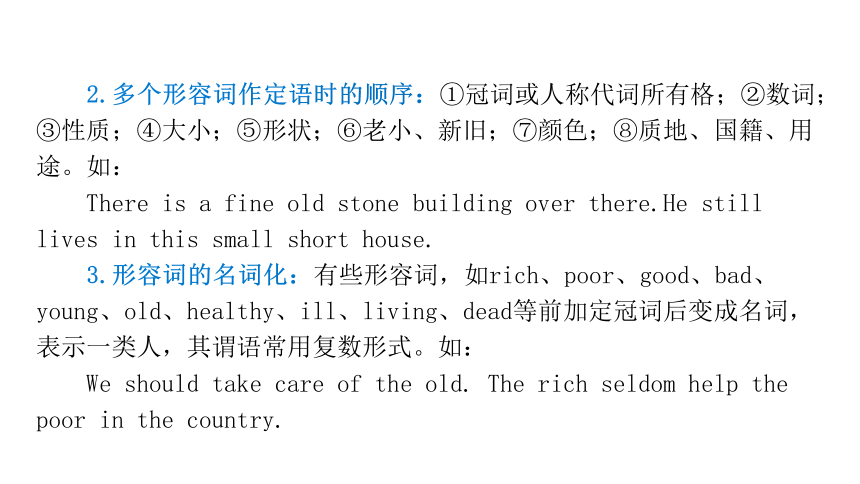
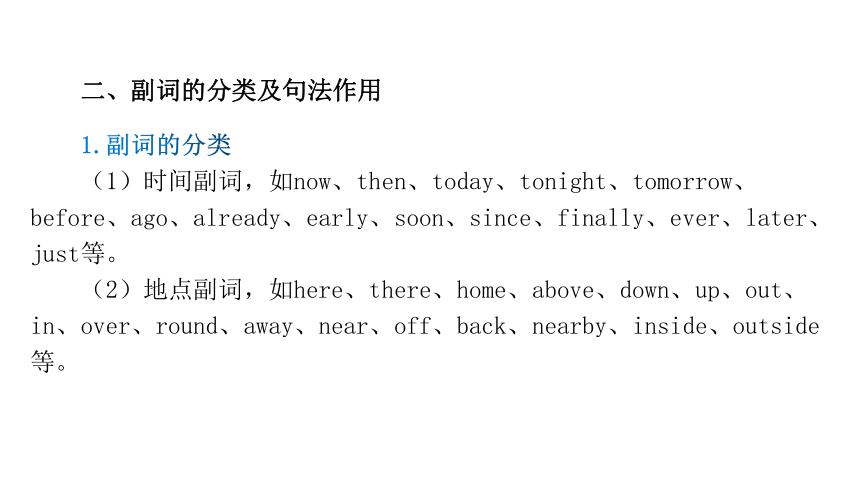
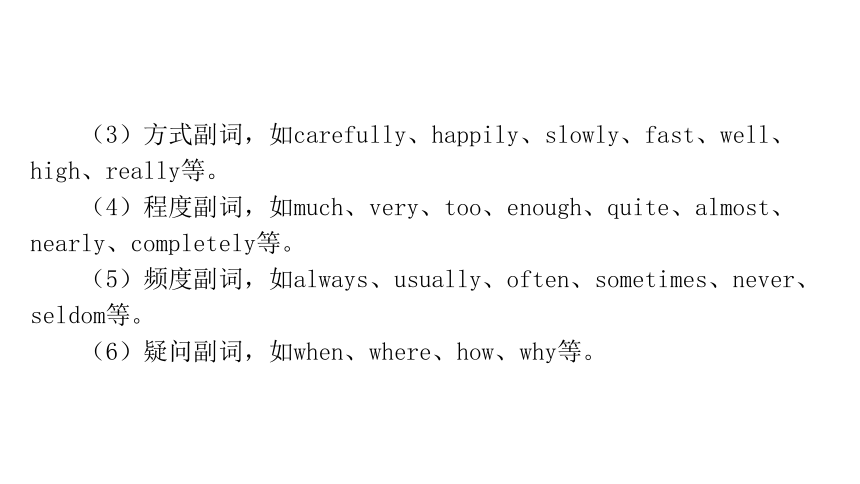
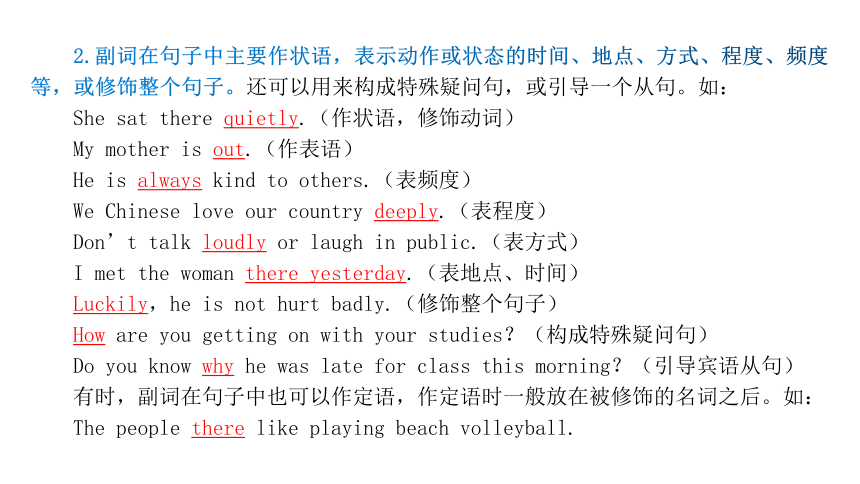
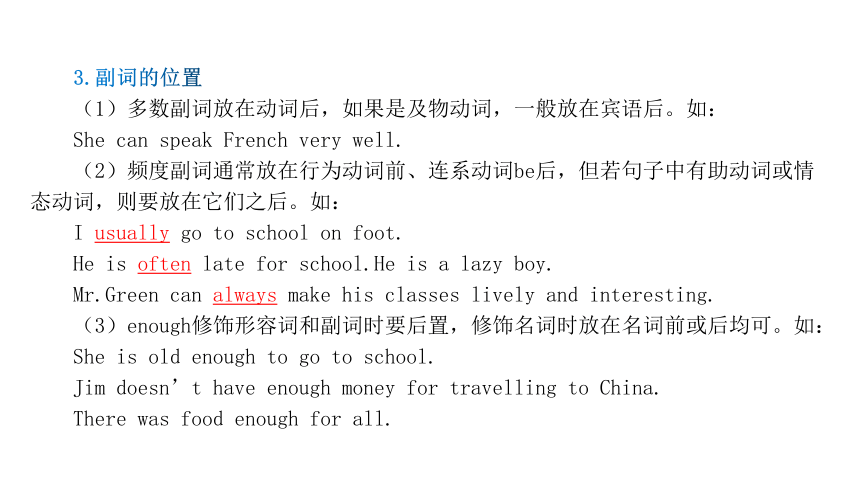

文档简介
(共35张PPT)
第二章 语法专题突破
第四节 形容词和副词
课标要求
知识网络
考点预测
01
02
03
考题剖析
04
巩固练习
05
01
课标要求
02
知识网络
形容词和副词的用法
一、形容词的主要句法作用
1.形容词的基本作用是对名词进行修饰、描绘,表示名词的性质、特征,在句子中可作定语、表语、宾语补足语、主语补足语等。
(1)作定语。如:This is an interesting book.
形容词作定语时,一般放在被修饰词之前,但若修饰不定代词,如something、anything、nothing、everything等时,要放在被修饰词之后。如:something new。
(2)作表语。如:The third lesson is difficult.
大多数形容词既可作定语,又可作表语,但少数形容词只能作表语,不作定语,如alone、afraid、asleep、ill等。如:
Don’t wake the asleep baby up.(误) The baby is asleep.Don’t wake him up.(正)
(3)作宾语补足语。如:They’re helping to make our school beautiful.
2.多个形容词作定语时的顺序:①冠词或人称代词所有格;②数词;③性质;④大小;⑤形状;⑥老小、新旧;⑦颜色;⑧质地、国籍、用途。如:
There is a fine old stone building over there.He still lives in this small short house.
3.形容词的名词化:有些形容词,如rich、poor、good、bad、young、old、healthy、ill、living、dead等前加定冠词后变成名词,表示一类人,其谓语常用复数形式。如:
We should take care of the old. The rich seldom help the poor in the country.
二、副词的分类及句法作用
1.副词的分类
(1)时间副词,如now、then、today、tonight、tomorrow、before、ago、already、early、soon、since、finally、ever、later、just等。
(2)地点副词,如here、there、home、above、down、up、out、in、over、round、away、near、off、back、nearby、inside、outside等。
(3)方式副词,如carefully、happily、slowly、fast、well、high、really等。
(4)程度副词,如much、very、too、enough、quite、almost、nearly、completely等。
(5)频度副词,如always、usually、often、sometimes、never、seldom等。
(6)疑问副词,如when、where、how、why等。
2.副词在句子中主要作状语,表示动作或状态的时间、地点、方式、程度、频度等,或修饰整个句子。还可以用来构成特殊疑问句,或引导一个从句。如:
She sat there quietly.(作状语,修饰动词)
My mother is out.(作表语)
He is always kind to others.(表频度)
We Chinese love our country deeply.(表程度)
Don’t talk loudly or laugh in public.(表方式)
I met the woman there yesterday.(表地点、时间)
Luckily,he is not hurt badly.(修饰整个句子)
How are you getting on with your studies?(构成特殊疑问句)
Do you know why he was late for class this morning?(引导宾语从句)
有时,副词在句子中也可以作定语,作定语时一般放在被修饰的名词之后。如:
The people there like playing beach volleyball.
3.副词的位置
(1)多数副词放在动词后,如果是及物动词,一般放在宾语后。如:
She can speak French very well.
(2)频度副词通常放在行为动词前、连系动词be后,但若句子中有助动词或情态动词,则要放在它们之后。如:
I usually go to school on foot.
He is often late for school.He is a lazy boy.
Mr.Green can always make his classes lively and interesting.
(3)enough修饰形容词和副词时要后置,修饰名词时放在名词前或后均可。如:
She is old enough to go to school.
Jim doesn’t have enough money for travelling to China.
There was food enough for all.
三、形容词和副词的比较级、最高级的构成
1.规则变化
2.不规则变化
四、形容词、副词的比较级、最高级的用法
1.表示两者程度相同时,用“A+as+形容词(副词)的原级+as+B”。如:
Jack is as tall as his sister. The little girl runs as fast as her pet dog.
2.在表示一方不如另一方时,用“A+not as(so)+形容词(副词)的原级+as+B”。如:My dog is not as old as yours.
3.在表示一方超过另一方时,用“A+形容词(副词)比较级+than+B”。如:
My bike is newer than yours. Lucy writes more carefully than Lily.
4.在表示三者或三者以上的人或事物中谁的程度最高时,用“the+形容词(副词)的最高级+in/of/among”(副词最高级前的the可省略)。如:
Lin Tao is the tallest in our class. He jumps(the)highest of the three.
5.形容词和副词的一些句型和其他用法。
(1)“比较级+and+比较级”,表示“越来越……”。如:
When spring comes,the days get longer and longer.
Our city is getting more and more beautiful.
(2)“the+比较级,the+比较级”,表示“越……就越……”。如:
The more we get together,the happier we will be.
The busier she was,the happier she felt.
(3)“A is ...times as+形容词原级+as+B”表示“A是B的……倍……”。如:
Their school is three times as big as ours.
(4)比较级前可用much、far、a lot、a little、a bit、even等修饰。如:
He is a little older than I.
(5)当表示两者中(有of the two这一比较范围)较……的那一个时,比较级前要加定冠词the。如:He is the taller of the two.
(6)表示在三者或三者以上的人或物中进行选择时,用“Which/Who is+ the+ 最高级,A,B or C?”结构。如:Which is the biggest,the sun,the earth or the moon?
(7)表示“最……的之一”时,用“one of the+形容词最高级+名词复数”结构,如:Sun Li is one of the most popular actresses.
(8)形容词最高级前面可以加序数词,表示“第几(最)……”。如:
The Changjiang River is the first longest river in China.长江是中国第一长河。
(9)形容词最高级前有物主代词或名词所有格时不再用定冠词the。如:Yesterday was his busiest day.昨天是他最忙的一天。
(10)形容词比较级结构可以表示最高级含义,在同一范围内比较时,必须把主体排除在被比较的范围之外,如:China is larger than any other country in Asia.
中国比亚洲其他任何一个国家都大。(在同一范围内,只能和其他对象进行比较。)
China is larger than any country in Africa.
中国比非洲的任何一个国家都大。(在不同范围内,可以和其中任意一个对象进行比较。)
03
考点预测
中考对形容词、副词的考查主要集中在以下四个方面:
1.形容词、副词的各种用法;
2.形容词、副词的比较等级;
3.各种表示比较的句型;
4.形容词、副词构成的一些重要短语及句型,动词与副词搭配构成的短语。
04
考题剖析
05
巩固练习
best
fattest
heaviest
finest
most
greatest
best
easily
largest
funniest
faster
dirtier
little
difficult
taller
slowly
early
early
more
better
beautiful
carefully
D
D
D
C
B
C
C
B
D
C
B
A
C
B
D
本 课 结 束
第二章 语法专题突破
第四节 形容词和副词
课标要求
知识网络
考点预测
01
02
03
考题剖析
04
巩固练习
05
01
课标要求
02
知识网络
形容词和副词的用法
一、形容词的主要句法作用
1.形容词的基本作用是对名词进行修饰、描绘,表示名词的性质、特征,在句子中可作定语、表语、宾语补足语、主语补足语等。
(1)作定语。如:This is an interesting book.
形容词作定语时,一般放在被修饰词之前,但若修饰不定代词,如something、anything、nothing、everything等时,要放在被修饰词之后。如:something new。
(2)作表语。如:The third lesson is difficult.
大多数形容词既可作定语,又可作表语,但少数形容词只能作表语,不作定语,如alone、afraid、asleep、ill等。如:
Don’t wake the asleep baby up.(误) The baby is asleep.Don’t wake him up.(正)
(3)作宾语补足语。如:They’re helping to make our school beautiful.
2.多个形容词作定语时的顺序:①冠词或人称代词所有格;②数词;③性质;④大小;⑤形状;⑥老小、新旧;⑦颜色;⑧质地、国籍、用途。如:
There is a fine old stone building over there.He still lives in this small short house.
3.形容词的名词化:有些形容词,如rich、poor、good、bad、young、old、healthy、ill、living、dead等前加定冠词后变成名词,表示一类人,其谓语常用复数形式。如:
We should take care of the old. The rich seldom help the poor in the country.
二、副词的分类及句法作用
1.副词的分类
(1)时间副词,如now、then、today、tonight、tomorrow、before、ago、already、early、soon、since、finally、ever、later、just等。
(2)地点副词,如here、there、home、above、down、up、out、in、over、round、away、near、off、back、nearby、inside、outside等。
(3)方式副词,如carefully、happily、slowly、fast、well、high、really等。
(4)程度副词,如much、very、too、enough、quite、almost、nearly、completely等。
(5)频度副词,如always、usually、often、sometimes、never、seldom等。
(6)疑问副词,如when、where、how、why等。
2.副词在句子中主要作状语,表示动作或状态的时间、地点、方式、程度、频度等,或修饰整个句子。还可以用来构成特殊疑问句,或引导一个从句。如:
She sat there quietly.(作状语,修饰动词)
My mother is out.(作表语)
He is always kind to others.(表频度)
We Chinese love our country deeply.(表程度)
Don’t talk loudly or laugh in public.(表方式)
I met the woman there yesterday.(表地点、时间)
Luckily,he is not hurt badly.(修饰整个句子)
How are you getting on with your studies?(构成特殊疑问句)
Do you know why he was late for class this morning?(引导宾语从句)
有时,副词在句子中也可以作定语,作定语时一般放在被修饰的名词之后。如:
The people there like playing beach volleyball.
3.副词的位置
(1)多数副词放在动词后,如果是及物动词,一般放在宾语后。如:
She can speak French very well.
(2)频度副词通常放在行为动词前、连系动词be后,但若句子中有助动词或情态动词,则要放在它们之后。如:
I usually go to school on foot.
He is often late for school.He is a lazy boy.
Mr.Green can always make his classes lively and interesting.
(3)enough修饰形容词和副词时要后置,修饰名词时放在名词前或后均可。如:
She is old enough to go to school.
Jim doesn’t have enough money for travelling to China.
There was food enough for all.
三、形容词和副词的比较级、最高级的构成
1.规则变化
2.不规则变化
四、形容词、副词的比较级、最高级的用法
1.表示两者程度相同时,用“A+as+形容词(副词)的原级+as+B”。如:
Jack is as tall as his sister. The little girl runs as fast as her pet dog.
2.在表示一方不如另一方时,用“A+not as(so)+形容词(副词)的原级+as+B”。如:My dog is not as old as yours.
3.在表示一方超过另一方时,用“A+形容词(副词)比较级+than+B”。如:
My bike is newer than yours. Lucy writes more carefully than Lily.
4.在表示三者或三者以上的人或事物中谁的程度最高时,用“the+形容词(副词)的最高级+in/of/among”(副词最高级前的the可省略)。如:
Lin Tao is the tallest in our class. He jumps(the)highest of the three.
5.形容词和副词的一些句型和其他用法。
(1)“比较级+and+比较级”,表示“越来越……”。如:
When spring comes,the days get longer and longer.
Our city is getting more and more beautiful.
(2)“the+比较级,the+比较级”,表示“越……就越……”。如:
The more we get together,the happier we will be.
The busier she was,the happier she felt.
(3)“A is ...times as+形容词原级+as+B”表示“A是B的……倍……”。如:
Their school is three times as big as ours.
(4)比较级前可用much、far、a lot、a little、a bit、even等修饰。如:
He is a little older than I.
(5)当表示两者中(有of the two这一比较范围)较……的那一个时,比较级前要加定冠词the。如:He is the taller of the two.
(6)表示在三者或三者以上的人或物中进行选择时,用“Which/Who is+ the+ 最高级,A,B or C?”结构。如:Which is the biggest,the sun,the earth or the moon?
(7)表示“最……的之一”时,用“one of the+形容词最高级+名词复数”结构,如:Sun Li is one of the most popular actresses.
(8)形容词最高级前面可以加序数词,表示“第几(最)……”。如:
The Changjiang River is the first longest river in China.长江是中国第一长河。
(9)形容词最高级前有物主代词或名词所有格时不再用定冠词the。如:Yesterday was his busiest day.昨天是他最忙的一天。
(10)形容词比较级结构可以表示最高级含义,在同一范围内比较时,必须把主体排除在被比较的范围之外,如:China is larger than any other country in Asia.
中国比亚洲其他任何一个国家都大。(在同一范围内,只能和其他对象进行比较。)
China is larger than any country in Africa.
中国比非洲的任何一个国家都大。(在不同范围内,可以和其中任意一个对象进行比较。)
03
考点预测
中考对形容词、副词的考查主要集中在以下四个方面:
1.形容词、副词的各种用法;
2.形容词、副词的比较等级;
3.各种表示比较的句型;
4.形容词、副词构成的一些重要短语及句型,动词与副词搭配构成的短语。
04
考题剖析
05
巩固练习
best
fattest
heaviest
finest
most
greatest
best
easily
largest
funniest
faster
dirtier
little
difficult
taller
slowly
early
early
more
better
beautiful
carefully
D
D
D
C
B
C
C
B
D
C
B
A
C
B
D
本 课 结 束
同课章节目录
- 词法
- 名词
- 动词和动词短语
- 动词语态
- 动词时态
- 助动词和情态动词
- 非谓语动词
- 冠词
- 代词
- 数词和量词
- 形容词副词及其比较等级
- 介词和介词短语
- 连词和感叹词
- 构词法
- 相似、相近词比较
- 句法
- 陈述句
- 一般疑问句和否定疑问句
- 特殊疑问句及选择疑问句
- 反意疑问句
- 存在句(There be句型)
- 宾语从句
- 定语从句
- 状语从句
- 主谓一致问题
- 简单句
- 并列句
- 复合句
- 主谓一致
- 主、表语从句
- 名词性从句
- 直接引语和间接引语
- 虚拟语气
- 感叹句
- 强调句
- 倒装句
- 祈使句
- 句子的成分
- 句子的分类
- 题型专区
- 单项选择部分
- 易错题
- 完形填空
- 阅读理解
- 词汇练习
- 听说训练
- 句型转换
- 补全对话
- 短文改错
- 翻译
- 书面表达
- 任务型阅读
- 语法填空
- 其他资料
